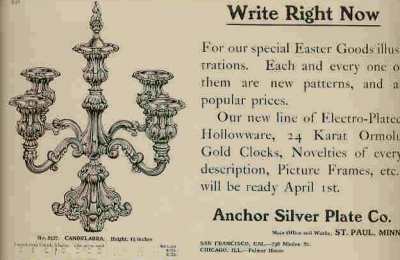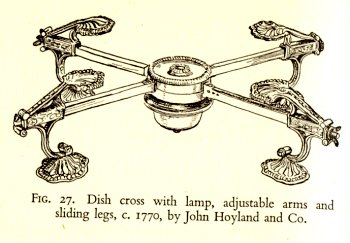Alessandro
Colemann receives these replies to his question
about his Victorian ladle:
( see September Newsletter)
Robert Massart writes:
... I also like to react on the question of
Alessandro Coleman. Indeed his spoon is a King's
pattern salt spoon, made in London and dating from
1846-1847 (ref. Jackson's Hallmarks, edited by Ian
Pickford).
The maker's mark (GA in 2 conjoining circles) is of
George G. William Adams of Chawner & Company, Hosier
Lane workshops, Smithfield; a most important mid
19th century firm of spoon makers.
The king's pattern design features honeysuckle
flowers and shell motif. It was designed by brothers
John and Henry Lyas in the 1830's when George IV was
on the throne in England.
Robert Massart
Wendy Posner receives these replies to her
question about her niello cigarette box:
( see September Newsletter)
Willand Ringborg writes:
... The silversmith AE could be either
Alexander Sergeevich Yegonov 1868-1897 in
Moscow, or Alexei Nikolaeievich Yegonov,
mentioned 1912 in Moscow.
The assaymaster 1893 AC is Alexander
Alexeevich Smirnov who was assayer in the
Moscow 1860 - 1894 (1893 in the company of 4
other assayers, all with separate initials).
Willand Ringborg
Wendy Posner
receives these replies to the
question about her twelve charger
plates:
( see September Newsletter)
Willand Ringborg writes:
... The plates are of Swedish
origin, and the abbreviation GAB is
to be interpreted as
"Guldsmedsaktiebolaget", Gold
smith's Ltd. The company was created
in 1868 by several goldsmiths in
Stockholm and it still remains. Its
production has been mainly silver
services and gold jewellery in bulk
quantities.
The stamps on the pieces you have
are to be understood: NS asan
abbreviation for "nysilver" in
Swedish ("new silver"), which then
means plated silver and Alp of
course for alpacca.
Willand Ringborg
"A PAGE
per MONTH"
In this
column we present a page (one page
only) obtained from makers'
brochures, books, auction catalogs
or whatever other printed paper,
which may be of particular interest
for ASCAS members.
The images will be published at a
"low resolution" level and for
private and personal use only

|
This month ASCAS presents an
ANCHOR SILVER PLATE CO.
advertising in a 1905 (not
identified) magazine,
publicizing " ... our new
line of Electro-Plated
Holloware, 24 Karat Ormolu
Gold Clocks, novelties of
every description, Picture
frames, etc. ... "
Anchor Silver Plate Co -
Muncie, Indiana and St.
Paul, Minnesota was listed
in 1898 and 1904 Jewellers'
Circular. Listed in 1909 JC
as out of business.
(ref: Encyclopedia of
American Silver
Manufacturers)
|
"A WORD
per MONTH"
In this
column we presents an abstract from
a page of the "What is? Silver
Dictionary"
courtesy of


|
DISH CROSS
this was a utilitarian
piece of silver used during
the last half of the 18th
century.
The center held a spirit
lamp or a candle so food
could be kept warm.
The four arms could be
spread and adjusted to hold
either round or oblong
dishes........
more
|
"A BOOK
ON MY SHELF"
In this
column we present books, new or
ancient, dealing with silver in all
its aspects (history, marks,
oddities...). This isn't a "book
review" but only a fair presentation
of some useful "tools" that anyone
may have in the shelf of his
bookcase.
(click to enlarge images)
The
"book on the shelf" of this month is
SILVER: PEWTER:
SHEFFIELD PLATEby Fred. W.
Burgess
printed by
GEORGE ROUTLEDGE & SONS. LTD. London
E.P. DUTTON & CO New York
1921
The Silver Society of Australia
Newsletter
On October 15th The Silver
Society of Canada published its
October 2007 Newsletter.
The Newsletter contains many
informative pages about the matter
of common interest (Members' Silver,
Auction Results, Mail) and articles
on "Silver with Personality", "
Australian Spoon Identification" and
"Sargison Workshop Hobart", quoting
also September ASCAS Newsletter and
its articles.
Australian (and non-Australian)
members of ASCAS interested to
subscribe to The Silver Society of
Australia may contact John Heathers
(Treasurer) at john.heathers@gmail.com
Closing our
OCTOBER/NOVEMBER 2007 edition of
ASCAS Newsletter I hope you have
appreciated its content.
Your comments, suggestions and
advice will be of great help.
My
thanks to Dominique Bochet (France),
Allen Carlson (USA), Alessandro
Colemann (Italy), Debbi Cracovia
(USA), Jayne Dye (USA), Mario
Galasso (Italy), Robert Massart (Belgium),
Willand Ringborg (Sweden), Fredric
Sinfield (Australia) for their
invaluable contributions.
Giorgio Busetto
Secretary
DISCLAIMER AND PRIVACY
POLICY
ASCAS is a community of
people having a common
interest in antique silver.
It is a non-profit
association without
commercial links. Membership
is open to whomever has a
true interest in this
subject matter.
ASCAS has no real property
and no fees are requested
nor accepted from members.
ASCAS keeps in touch with
its members only through
periodical newsletters,
e-mails and web-site
updating and ignores and is
not responsible for any
other activity pursued by
its members.
Likewise, ASCAS is not
responsible for opinions,
evaluation and images
displayed, and in any form
published or supplied for
publication, by its members
who, in any case, maintain
the property of their works
and assure the respect of
national and international
legislation about
Intellectual Property.
ASCAS does not have the full
addresses of its members (only
town, country and e-mail
address are requested for
membership).
ASCAS handles and protects
with care its members e-mail
addresses, will not disclose
the addresses to third
parties, will use this
information only to reply to
requests received from
members and for
communications strictly
related to its activity.
These rules are expressly
accepted by submitting the
membership request.
|
|
|
|
|
|
 newsletter # 42 - OCTOBER-NOVEMBER 2007
newsletter # 42 - OCTOBER-NOVEMBER 2007